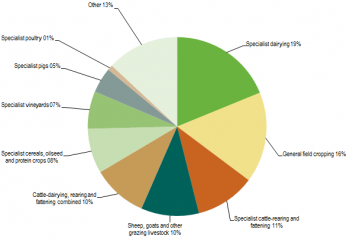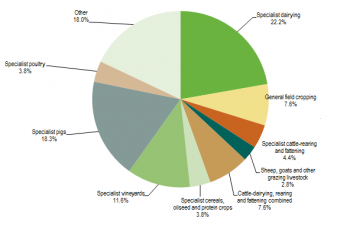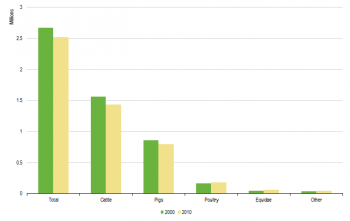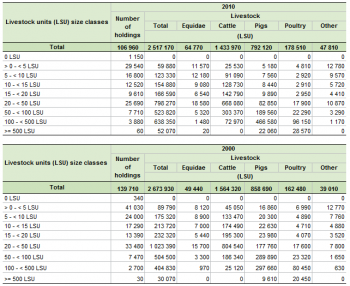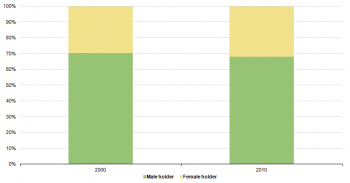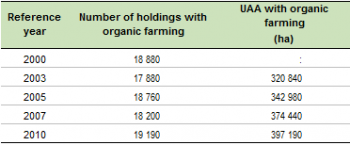Archive:Agricultural census in Germany
- Data from November 2012. Most recent data: Further Eurostat information, Main tables and Database.
This article is part of a series of country-specific essays on the results of the European Union (EU) Farm structure survey (FSS) 2010. The FSS collects information on the structural characteristics of the agricultural holdings (land use, livestock and labour force) and is carried out every 10 years as an Agricultural census by all the EU Member States, with two or three additional, intermediate sample surveys carried out in-between. The present analysis of the German farm structure includes a comparison with the previous (2000) Agricultural census.

Source: Eurostat (ef_kvaareg) (ef_ov_kvaa) (demo_pjan) and FSS 2000 and 2010
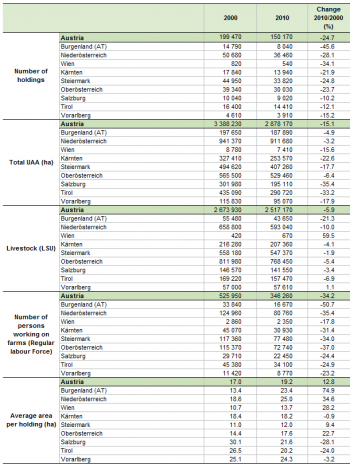
Source: Eurostat (ef_kvaareg) (ef_ov_kvaa) and FSS 2000 and 2010

Source: Eurostat (ef_kvaareg) (ef_ov_kvaa)
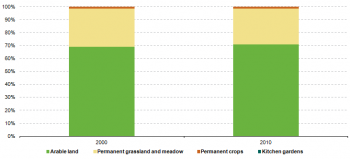
Source: Eurostat (ef_lu_ovcropaa) (ef_oluaareg)
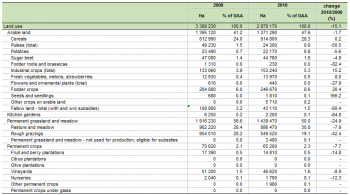
Source: Eurostat (ef_lu_ovcropaa) (ef_oluaareg)

Source: Eurostat (ef_mptenure)

Source: Source: Eurostat (ef_pmhouscatlaa)
Main statistical findings
Key indicators
In 2010, 299 100 agricultural holdings were recorded in Germany; among the other EU Member States, Portugal (305 270) and Lithuania (199 910) registered similar values. Compared to the FSS 2000, when 399 350 farms were recorded, one fourth of the German holdings ceased their activity (- 100 250).
On the contrary, the utilised agricultural area (UAA) remained fairly stable (-1.4 %) over the inter-census decade, indicating the value of 16.7 million of hectares in 2010: in absolute terms, the UAA decreased by 240 660 ha in ten years. Hence, in 2010 the agricultural land was found to cover 47 % of the German territory, which was one of the highest shares within the EU-27.
Given that the number of holdings decreased and the agricultural land remained stable, the average area per farm grew remarkably (+ 31.6 %) in Germany – from 42.4 hectares per holding in 2000 to 55.8 ha in 2010. This meant that Germany, whose agricultural structure had already proved to be characterised by broad farms in 2000, recorded one of the highest values within the EU-27 in 2010.
Over the inter-census timeframe, the number of persons regularly working on the farms decreased by about one fourth. Hence, in 2010 the value for the aforementioned indicator fell under the 1 million threshold. In absolute terms, about 268 000 persons left the agricultural sector between the two reference years, so 749 740 persons were found to be regularly working on the farms in 2010. Accordingly, in 2010 the German agricultural labour force represented 1.8 % of the active population , one of the lowest values recorded among the EU Member States.
The German livestock population – expressed in livestock units (LSU) – indicated the value of 17.8 million in 2010 – one of the highest figures registered within the EU-27 alongside France where it stood at 22.7 millions LSU. Compared to the FSS 2000, a decrease of 1.4 millions LSU was observed (- 7.2 %).
Regional key indicators
The regional analysis exhibited in Table 2 further details the structure of the German agriculture. If the number of holdings is taken in to consideration, the territory of Bayern appears to be the most important, as about one third of the German farms (97 870) was recorded within its borders. The second highest value was recorded in Baden-Württemberg (44 510) and corresponded to 15 % of the German agricultural holdings. Other remarkable figures were registered in Niedersachsen (41 730) and Nordrhein-Westfalen (35 750): the former territory accounted for 14 % of the German population of farms and the latter for 12 %. The metropolitan region of Berlin-Bremen-Hamburg , which merges data from these three urban areas, proved to be marginal and accounted for 0.3 % of the German agricultural holdings: in 2010, only 1 010 farms were recorded within its borders.
In terms of the agricultural area, the south-eastern region of Bayern recorded the highest value, as it accounted for over 3 million hectares – 19 % of the whole German UAA in 2010. The territory of Niedersachsen registered the second highest figure (2.6 million hectares) and accounted for 15 % of the total agricultural area, the very same share recorded in 2000. The regions of Nordrhein-Westfalen (9 %), Baden-Württemberg (8 %) and Mecklenburg-Vorpommern (8 %) recorded very similar values and were found to be the closest to the 10 % threshold. On the other end of the scale, the metropolitan area of Berlin-Bremen-Hamburg (24 760 ha) proved to be marginal, as it accounted for only 0.1 % of the country’s agricultural area in 2010: the very same share recorded in 2000.
In terms of animal livestock, the territory of Niedersachsen proved to be the most important one: 4.5 million LSU were registered within its boarders, a value corresponding to 25 % of the German farm animal population. The southern-east region of Bayern recorded the second highest value (3.6 million LSU) and shared 20 %, whereas the only other remarkable value (2.8 million LSU) was found in Nordrhein-Westfalen, which accounted for 16 % of the German livestock population in 2010.
As regards the labour force, the south-eastern region of Bayern showed the highest number of persons working on farms (219 010), corresponding to 29 % of the total agricultural labour force in 2010. The south-western region of Baden-Württemberg recorded the second highest figure (110 850) and accounted for 15 %; Niedersachsen (13 %) and Nordrhein-Westfalen (11 %) recorded similar values.
Finally, the regional analysis of the average area per holding shows large differences among the territories and highlights the peculiarity of the region of Mecklenburg-Vorpommern (286 ha per farm), Sachsen-Anhalt (278 ha), Brandenburg (238 ha), Thüringen (215 ha) and Sachsen (145 ha). All these regions displayed values much higher than the national average of 56 hectares in 2010.
Agricultural holdings
About half (47 %) of the German agricultural holdings reported 5 to 29.9 hectares of UAA in 2010: these medium-sized farms covered roughly 2 million hectares of agricultural land, a value that corresponded to merely 12 % of the whole German UAA. On the other hand, 130 340 farms (44 %) recorded 30 hectares or more of UAA and accounted for 87 % of the German agricultural area (over 14 million of hectares) in 2010. Furthermore, 27 360 farms recorded less than 5 hectares of UAA in Germany: in 2010, these small sized agricultural holdings covered 54 000 hectares and represented less than 1 % of the German agricultural land.
As exhibited in Figure 1, farms with 10 to 19.9 hectares of UAA were the most common as they represented 21 % of the entire population of holdings (63 160). In terms of the number of holdings, the second highest share was reported by farms with 5 to 9.9 hectares of UAA (47 310), which represented 16 % of the German agricultural holdings in 2010. A very similar share was registered by holdings with 30 to 49.9 hectares of agricultural area (15 %).
In Germany, a decrease in the number of holdings was found to affect all the categories of farms, with the exception of the biggest ones, i.e. farms with 100 hectares or more of UAA. Indeed, within the inter-census decade, these quite big holdings recorded a remarkable growth (+ 38 %).
See detailed data at NUTS 2 level for 2010
Economic size of the farm
The economic size of all the German agricultural holdings (see Table 3) indicated the value of EUR 41 494 million, one of the highest figures recorded within the EU-27 in 2010. Nonetheless, compared to the FSS 2007, this value – calculated by adding all the standard output (SO) per hectare of crop and per head of livestock of the farms – represented a 5.6 % decrease.
Agricultural holdings with an economic size of EUR 500 000 or more were found to be the most important ones as they accounted for 37 % of the German economic output in 2010. Also farms with an economic output of EUR 100 000 to 249 999 appeared significant, as they accounted for one fourth of the country’s standard output in 2010. The aforementioned classes of farms proved to be on a negative trend compared to 2007, although in both cases the decrease reported was found to be below the national average value of -5.6 %.
The territorial analysis of the economic output of the farms reveals the importance of the territories of Niedersachsen and Bayern, as together they accounted for about 40 % of the German standard output in 2010. In particular, Niedersachsen reported the highest share (21 %), whereas Bayern accounted for 19 %, a value that corresponded to EUR 7 698 million.
See detailed data at NUTS 2 level for 2010 and 2007
Agricultural holding by main type of farming
As presented in Figure 2, holdings specialised in dairying proved to be the most common in Germany when the main type of farming is taken into account: in 2010, they represented 22 % of the total population of farms. The second highest share was recorded by both farms specialised in general field cropping (12 %) and those dedicated to the production of cereals, oilseed and protein crops (12 %). Furthermore, agricultural holdings specialised in cattle-rearing and fattening (9 %) fell just below the 10 % threshold.
In terms of the economic size of the farms the ranking is quite different. However, agricultural holdings dedicated to dairying (26 %) maintained their prevalence within the structure of the German agriculture, whereas farms specialised in pigs recorded the second highest share (12 %): a value slightly smaller than the one recorded by farms dedicated to general field cropping (11 %).
See detailed data at NUTS 2 level for 2010
Land use
The Utilised Agricultural Area (UAA) is the total area – taken up by arable land, permanent grassland and meadow, permanent crops and kitchen gardens – used by the holding, regardless of the type of tenure or whether it is used as a part of common land.
In Germany the UAA is essentially made of arable land and permanent grassland and meadow. Indeed, merged together these two components covered 99 % of the country’s agricultural area in 2010, the very same percentage they took up in 2000. Over the inter-census decade, arable land slightly increased its share over the total agricultural area (+1 %), gaining about 103 000 hectares. On the contrary, the relative weight of permanent grassland and meadow decreased, (-7 %) as it actually lost 336 000 hectares of agricultural land.
See detailed data at NUTS 2 level for 2010
Arable land
In 2010 arable land was taken up by cereals, fodder crops and industrial crops. Cereals reported the highest share as they proved to cover 6.6 million hectares of agricultural land, a value corresponding to 39.5 % of the German UAA. Fodder crops accounted for 15.4 % of the country’s agricultural land and covered 2.6 million hectares: in absolute terms, this type of harvest gained 869 000 ha over the inter-census decade. Industrial crops were found to take up 1.5 million hectares and accounted for 9.2 % of the German UAA.
See detailed data at NUTS 2 level for 2010
Permanent grassland and meadow
Between 2000 and 2010, permanent grassland and meadow decreased by about 336 000 hectares, accounting for 28 % of the German agricultural area in 2010. In particular, the area dedicated to rough grazing, which represents the smaller portion of permanent grassland and meadow, gained about 53 000 hectares (+39 %). On the contrary, the land dedicated to pasture and meadow decreased (-411 000 ha), indicating the value of 4.4 million hectares in 2010.
See detailed data at NUTS 2 level for 2010
Livestock
Statistics on livestock can be measured either in livestock units (LSU) or number of heads (number of animals), with the LSU allowing comparison between different types.
Over the inter-census timeframe, the number of livestock decreased by 7 % in Germany. Hence, in 2010 it indicated the value of 17.8 million LSU, one of the highest figures reported within the EU-27, together with the one registered in France and Spain.
Representing half of the German livestock population, cattle were by far the most common type of farm animals in 2010: 9 million LSU of cattle were reported, a figure which represented a 14 % decrease compared to 2000. In terms of LSU, also pigs were found to be relevant as 6.4 million of them were reported in 2010 – a value corresponding to 36 % of the whole country’s population of farm animals. With a share of 10 %, poultry recorded the third relevant share in Germany and the only other value exceeding the 1 million LSU threshold.
Over the timeframe under analysis, the decrease in the number of livestock (- 7.2 %) was sharper than the fall in the population (- 0.4 %). As a result, the number of livestock per inhabitant in Germany slightly decreased, moving from 0.23 to 0.22. Moreover, the share of agricultural holdings with farm animals over the population of farms fell, from 77 % in 2000 to 72 % in 2010.
The decrease in the number of holdings characterised all the classes of farms but the largest one. Indeed, farms with 500 or more LSU actually increased (+46 %), as their number changed from 2 880 in 2000 to 4 210 in 2010. On the other hand, the highest decrease was reported by holdings with 15 to 19 LSU (- 41 %) and those with 20 to 49 LSU (- 41 %).
The territorial analysis of livestock highlighted the importance of the regions of Niedersachsen, Bayern and Nordrhein-Westfalen, which together accounted for 61 % of the German farm animal population. In particular, the regions of Niedersachsen reported the highest share (25 %); Bayern accounted for 20 %; further 16 % of the German livestock was registered within the territory of Nordrhein-Westfalen in 2010.
See detailed data at Nuts 2 level for 2010 and 2000
Labour force
In Germany, the agricultural labour force dropped by about one fourth over the period under analysis. As displayed in Table 6, over one million persons were regularly working in agriculture in 2000, whereas only 749 740 were reported in 2010. If the annual work unit (AWU) is taken into account, the decrease looks less sharp (-14.25 %), as figures moved from 571 000 AWU in 2000 to 489 660 AWU in 2010.
The regional analysis of the agricultural labour force underlines the relevance of the region Bayern, Baden-Württemberg, Niedersachsen and Nordrhein-Westfalen, which together accounted for 68 % of the German regular agricultural labour force in 2010. In particular, 29 % of farm employees were reported in Bayern; Baden-Württemberg accounted for 15 %; Niedersachsen reported 13 % and Nordrhein-Westfalen recorded the smallest double digits share (11 %).
See detailed data at NUTS 2 level on holders' age and gender for 2010 and 2000
In terms of sole holders, the gender cleavage appeared to be marked as the share of female sole holders (10 %) was found to be marginal in 2010.
See detailed data at NUTS 2 level on type of labour force for 2010 and 2000
Management practices
Type of tenure
Contrary to most of the EU Member States where the agricultural area is mainly farmed by the owners, the majority of German UAA (59.8 %) in 2010 was found to be farmed by the tenants (see Table 7). Accordingly, the agricultural land farmed by the owners indicated the value of about 6.5 million hectares and accounted for 38.7 % of the total UAA. In addition, the portion of land utilised in partnership by the landlord and the sharecropper under a written or oral share-farming contract was found to be marginal (1.6 %).
Animal housing
According to the FSS 2010, there were 144 850 holdings farming about 12.5 million heads of cattle in Germany. About half of these farms were found to host cattle in loose housing with solid dung and liquid manure. Also the other type of loose housing (with slurry) proved to be very common, as it was reported in 45.8 % of the German holdings and accounted for over 7 million places, as exhibited in Table 9. It must be noted that farms could report more than one type of animal housing.
As seen in many other EU Member States, also in Germany the total number of places (14 061 480) exceeded the number of heads of cattle (12 534 510). Thus, in 2010 the hosting capacity of the country was not fully exploited, which explains why the related percentage was more than 100.
Other gainful activities
In Germany, 92 130 agricultural holdings recorded activities other than farm work, directly related to the holding and having an economic impact on it. These farms accounted for 31 % of the entire population of holdings, which was one of the highest shares reported within the EU-27 in 2010.
With over 34 000 farms reporting other gainful activities in Germany, the region of Bayern accounted for 11.5 % of German farms with extra source of income in 2010. The second highest percentage was registered in Baden-Württemberg (6 %) where 17 930 agricultural holdings confirmed having other gainful activities.
Information on other gainful activities was collected by eleven category types depending on their characteristics and each holding could register more than one activity.
As exhibited in Table 10, the most common source of extra income was found to be the production of renewable energy: it was recorded in 37 370 farms, a value corresponding to 40 % of farms with other gainful activities. Contractual work also proved to be relevant and it was reported in 23 040 agricultural holdings (25 %), whereas 22 580 farms proved to practice forestry work as extra source of income (24 %) in 2010.
See detailed data at NUTS 2 level for 2000
Organic farming
Organic agriculture is an ecological production management system that promotes and enhances biodiversity, biological cycles, and soil biological activity. It is based on the minimal use of off-farm inputs and on the management practices that restore, maintain or enhance ecological harmony.
See detailed data at Nuts 2 level for 2010, 2007, 2005, 2003 and 2000
As displayed in Table 11, 15 170 holdings were found to practice organic farming in Germany, a figure which represented one of the highest numbers recorded within the EU-27 in 2010. If the agricultural land dedicated to this practice is taken into account, Germany recorded the highest value (852 670 ha) in this respect among the EU Member States, followed by Italy (754 530 ha). In relative terms, the land dedicated to organic farming covered 5 % of the German agricultural land.
Data sources and availability
Methodological notes
In Germany, the FSS has been conducted as a sample survey every two or three years since 1975. Moreover, in compliance with the EU legislations, the FSS is conducted as a census every ten years (roughly). In 2010, the implementation of the FSS and the Survey on agricultural production methods was decentralised. The Federal Statistical Office was responsible for the coordination of the local offices and ensured the technical and methodological soundness of both surveys; the statistical offices of the Länder were responsible for the data collection, the results at NUTS 1 level and the selection of samples for the Survey on agricultural production methods.
Survey on agricultural production methods (SAPM)
In 2010 a unique survey was carried out together with the Agricultural census: the Survey on agricultural productions methods (SAPM). This survey collected data at regional level needed to establish agri-environmental indicators as indicated in COM final 508/2006 and to evaluate the greening of the Common agricultural policy.
Data were collected according to specifications listed in Annex V of regulation regulation 1166/2008, namely data on tillage methods, soil conservation, landscape features, animal grazing, animal housing, manure application, manure storage and treatment facilities and irrigation.
In Germany, the SAPM was conducted as a sample survey together with the Agricultural census; a stratified sampling procedure was employed and about 78 000 holdings were selected from the sampling frame.
Reference period
Data on the Agricultural census 2010 were collected with reference to the first six months of 2010. In particular, information on livestock was collected as of the 1st of March 2010, whereas data on the agricultural labour force refer to the March 2009 – February 2010 timeframe (to be confirmed by EUROSTAT).
Threshold for agricultural holdings
In Germany, the Agricultural census 2010 targeted all agricultural holdings with at least 5 hectares of agricultural land. Moreover, farms falling below this threshold, based on UAA but complying with a set of different physical thresholds related to the hectares of certain types of crops or heads of cattle, were also included in the target population.
Although they are in line with the requirements set by the EU regulations, the 2010 thresholds differ from the ones employed in 2000, when all farms with at least 2 hectares of UAA were targeted. Accordingly, to allow comparison over the two reference years, the 2000 data were filtered using the 2010 thresholds.
Common land
Common land is the land that does not directly belong to any agricultural holding but on which common rights apply. It can consist of pasture, horticultural or other land. The treatment of the common land used by an agricultural holding might differ from country to country.
In Germany, common land is not a widespread characteristic and is mostly covered by permanent grassland and meadow. Two different methodologies were used to collect information on common land, depending on the nature of its use. In particular, common land was included in the holdings that indicated its use or it was treated as a separate holding. In Bavaria common land was not surveyed.
Geo-reference of the holding
In Germany, information on the location of the farms was obtained by matching data from the statistical Farm register with the coordinates of the main building of the holding. Afterwards, the coordinates were rounded to 5 degrees, hence preventing the identification of single units.
Economic size
From FSS 2007 onward, the Standard output (SO), a new classification of the economic size of the holding, is used. The SO has replaced the Standard gross margin (SGM) used before. Nonetheless, for comparability reasons, both classifications are available in FSS 2007.
Other methodological issues
Comparability between FSS 2000, 2007 and 2010
Although in line with the EU regulations, the 5 hectares threshold used for the Agricultural census 2010 makes comparison with data from the previous waves of the FSS difficult. Indeed, until 2007 Germany conducted the Farm structure survey using lower thresholds, which allowed smaller farms to be targeted. Accordingly, in order to draft the present article and compare 2010 data with the ones from 2007 and 2000, the older datasets were filtered using the 2010 thresholds. Therefore, the FSS 2007 and 2000 figures mentioned within this article and presented in the tables exhibited, or available through hyperlinks, differ from the ones presented in the Eurostat online database. Nonetheless, to be thorough, hyperlinks to the online database were also provided throughout the article.
Territorial classification
The territorial analysis has been done using the NUTS 2 level in most of the country-specific essays on the results of the European Union Farm structure survey. Because of the peculiarities of the German NUTS classification and the fact that German regional data are published on the Eurostat database at NUTS 1 level, the regional analysis was done using the NUTS 1 classification.
Context
European Commission Rural development policy aims to improve competitiveness in agriculture and forestry, the environment and the countryside, as well as to improve the quality of life in rural areas, and to encourage the diversification of rural economies.
As agriculture has been modernised and the importance of industry and services within the economy has increased, agriculture has become much less important as a source of jobs. Consequently, increasing emphasis is placed on the role farmers can play in rural development, including forestry, biodiversity and the diversification of the rural economy, in order to create alternative jobs and provide environmental protection in rural areas.
The FSS continues to adapt in order to provide timely and relevant data to help analyse and follow these developments.
Further Eurostat information
Publications
- Agriculture, fishery and forestry statistics — Main results – 2010-11 - 2012 edition
- Farm Structure Survey in Austria - 2007 - Issue number 89/2009
- Farm Structure in Austria - 2005 - Issue number 11/2007
- Structure of Agricultural Holdings - Austria 2003 - Statistics in focus 36/2005
Main tables
- Agriculture, see:
- Structure of agricultural holdings (t_ef)
Database
- Agriculture, see:
- Structure of agricultural holdings (ef)
Dedicated section
Methodology / Metadata
- Structure of agricultural holdings (ESMS metadata file - ef_esms)
- Methodological Report – FSS 2010 Germany
- Methodological Report – FSS 2007 Germany
Source data for tables and figures (MS Excel)
Other information
- Regulation 1166/2008 of 19 November 2008 on farm structure surveys and the survey on agricultural production methods and repealing Council Regulation 571/88
- Regulation 1200/2009 of 30 November 2009 implementing Regulation 1166/2008 on farm structure surveys and the survey on agricultural production methods, as regards livestock unit coefficients and definitions of the characteristics
See also
- census 2010 Agricultural census 2010
- structure All farm structure articles by country (2007)
- structure statistics Farm structure statistics

